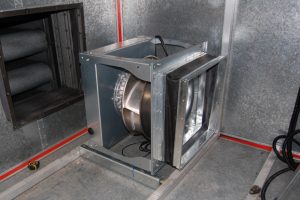The Mercedes-AMG Petronas Motorsport headquarters in Brackley, UK is where hundreds of engineers, technicians and designers contribute to the success of their World Championship Formula One team − seven days a week, all year round. In their number are 15 employees who staff the paint shop, responsible for adding the final layer of preparation to the race cars and equipment that lends the team its moniker of the Silver Arrows.
However, working in the paint shop during the hot summer months has never been much fun. Why was that? Following complete re-organization of the premises and workplaces, the air conditioning system no longer met the requirements of the employees. And the AC fans were difficult to regulate. The air was propelled through the ducts at such a rate that it literally whistled through the ceiling vents in the paint shop, creating a permanent background noise. To combat the noise nuisance, the employees would close or block the air outlets near their work stations. The consequence was that the atmosphere was hot and sticky in summer, despite having the air conditioning system operating at maximum output.
Too noisy, too inefficient, too expensive
This was an unsatisfactory situation for Mercedes-AMG Petronas Motorsport. “Our air conditioning system was too noisy, the temperature was erratic and what’s more, the operating costs were going up and up,” explains Robert Yeowart, Director Business Development & Logistics at Mercedes-AMG Petronas Motorsport. “With their concept for cooling our racing cars in the pits and for cooling the trackside garages, ebm-papst had already shown that they were capable of developing innovative solutions at a reasonable cost. So we consulted our team partner again with our latest problem.” ebm-papst product manager James Cooper took the matter in hand. His first step was to visit the Brackley headquarters to have a look at the system and take some initial measurements. In doing so, he discovered an extremely high pressure of 1,366 Pa, but at the same time an average air flow of only 6,000 cubic meters per hour. This was caused by the air conditioner outlets being almost completely closed. “The system was using a lot of energy without the employees actually having much benefit from the cooling output,” Cooper recalls.
Go-ahead for testing
To improve the system, Cooper proposed replacing the AC fans with EC fans, which are easy to adjust to the required speed. He further suggested fully re-opening the ceiling vents to optimize the system. The Fitting of user-friendly fan control would also enable facility managers to exactly adjust the system to any future requirements. The aim was to provide quiet-running, efficient and easy-to-adjust air conditioning for the paint shop. Robert Yeowart and his colleagues were convinced by these suggestions and gave the go-ahead for conversion of a trial unit in the paint shop. Together with an external partner, ebm-papst upgraded the A/C unit and replaced an old AC fan with two RadiPac EC fans from ebm-papst. These new fans were mounted in anti-vibration housings to keep the noise nuisance to an absolute minimum.
We received extremely positive feedback from the paint shop personnel, as the atmosphere was now pleasantly cool and quiet. Robert Yeowart, Mercedes-AMG Petronas Motorsport
The next step involved the retrofit team opening all the overhead air vents to be able to set the air conditioning system correctly. With an air flow of 8,000 m3/h at a pressure of 450 Pa, the air flowed almost noiselessly to the workplaces after a few adjustments and created a pleasant temperature. “For simple regulation, ebm-papst fitted a fan control system with a safety mechanism,” says Cooper. “The cold air for the air conditioner is generated by an evaporator coil. To stop this icing up, the air always has to travel through the system at a certain velocity. We programmed the control system in such a way that speeds below this minimum value cannot be set.”
Baptism of fire in a heat wave
As soon as the retro-fitting work was completed, the UK experienced one of the hottest weeks of the year — a real test for the converted air conditioning system in extreme conditions. “We received extremely positive feedback from the paint shop personnel, as the atmosphere was now pleasantly cool and quiet,” says Yeowart. “A further bonus is that freshly painted parts now dry better as the air is circulated evenly around the room.” The upgrade was a worthwhile investment in financial terms as well. Mercedes-AMG Petronas Motorsport can now save 64 per cent of the energy required for operating the air conditioning system. Which means that it will have paid for itself in just two years.
And finally, the upgrade had another unexpected benefit, as Yeowart explains: “Prior to the upgrade people used to open the doors to create a draft. Now these doors remain closed we have eliminated an unnecessary safety risk.” In view of the results obtained, Mercedes-AMG Petronas Motorsport decided to convert all the units in the paint shop and to consider further retrofitting across its sites in the future. “We are currently taking a look at the air conditioning systems throughout the plant,” says Yeowart. “We are keen to do the same sort of upgrade wherever it makes sense.”



Leave a comment